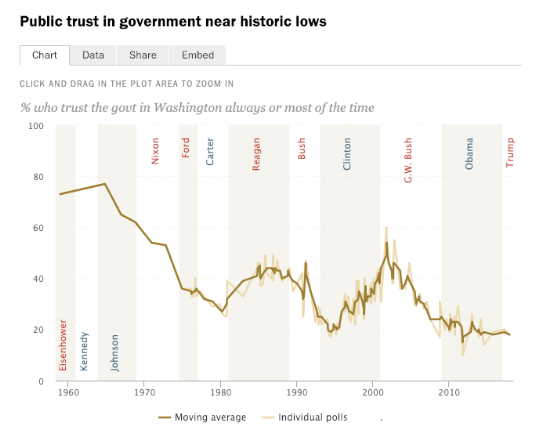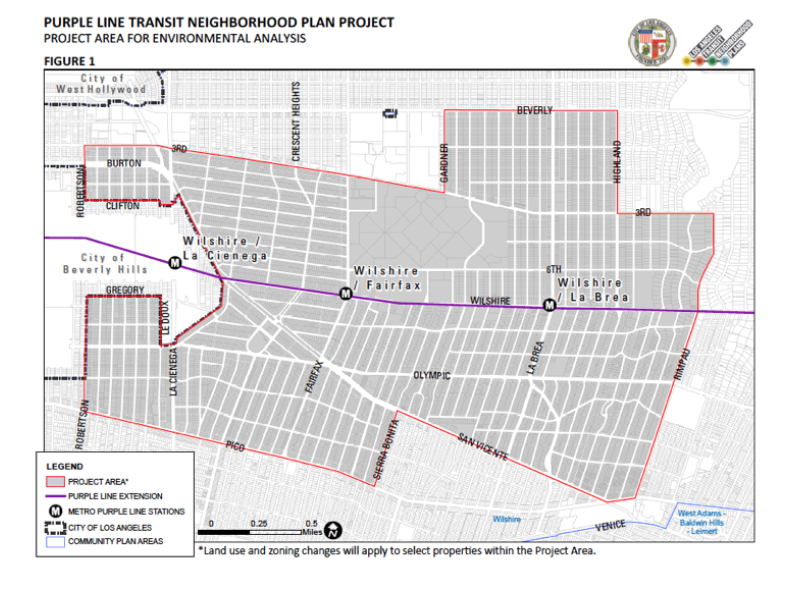CommentsPLATKIN ON PLANNING-As someone who worked for public agencies most of his career, it is disheartening – but not surprising -- to see data on the growing public distrust of government. While fully understandable, distrust is getting worse for both Trumpian and Garcettian reasons.

As the chart here demonstrates, within living memory public trust in government has fallen from 75 percent in the Eisenhower era to below 20 percent under Trump. While city governments generally fare better in these polls, Los Angeles is not among them. Our fair city has experienced two enormous civil disturbances (1965, 2002), LAPD consent degrees, City Hall pay-to-play scandals, world-class traffic congestion and bad air, crumbling sidewalks, and endless spin jobs to push mega-projects and up-zoning real estate schemes past the City Council finishing line.
While they all tarnish LA’s reputation, I want to zero in on the latter, the real estate spin jobs. They don’t get the press coverage of the Vietnam, Gulf I, Gulf II, and Afghan wars, as well as investor bailouts, all of which sank the reputation of the Federal Government, but they go a long way to explain why City Hall has become of the butt of two and four legged rat jokes. We laugh because we know these jokes are true!
To get a better understanding on how the these spin jobs have taken their toll on City Hall’s reputation, I want to carefully examine the most easily exposed lies pervading the Purple Line Extension Transit Neighborhood Plan. Hardly a new topic for me; these are the top eight lies City Hall rolls out for this project. After my inventory, I hope to explain why these lies are so brazen and why the liars are so persistent.
The Lies: The first four lies are found in the project’s name, Purple Line Extension Transit Neighborhood Plan or “TNP,” for short.

Lie # 1 in linking this TNP planning project to METRO’s Purple Line Extension subway project. A careful review of METRO’s website, including everything related to the actual subway project, does not show up even one reference to the TNP. Yes, a different METRO office gave LA City Planning a TNP starter grant, and the physical area of the TNP is near the Purple Line, but that is it. The TNP is not proposing any interfaces with LaBrea and Fairfax subway stations, and these subway stations have no connection to the proposed TNP, other than proximity.
Lie # 2 is the word Transit in the title. Those who live, work, visit, or shop in the TNP area and use transit, take buses, and there are over 200 METRO bus stops in the TNP study area (shown above), as well as two DASH Lines. Yet, the TNP totally ignores them. There are no plans or budget allocations to improve bus service, accessibility, and prices. Upgrading bus benches to bus shelters? Nope. Cleaner and safer busses? Nope. Electronic signs for departures and arrivals? Nope. Reducing fares? Nope. Real time cell phone apps? Nope. Reducing headways? Nope. These nopes tell the whole story.
Lie # 3 is the word Neighborhood in the title. he TNP proposal did not originate with any community groups in or near the TNP study area. In fact, none of them even knew about the project until July 2018, when City Planning held a DEIR scoping meeting for a project that they could not and still cannot define. Nine months later, City Planning has agreed to accept several community groups’ speaking invitations, where they were, unsurprisingly, roasted for foisting an extensive upzoning (i.e., increases in building densities, heights, and size) ordinance on local communities that local groups neither knew about nor wanted.
Lie # 4 is the word Plan in the title. The TNP is not a real plan, meaning it is part of LA’s General Plan. In fact, from its onset in 2013 its goal was to evade the City of LA’s ongoing General Plan review process, including the forthcoming update of Wilshire Community Plan. Instead the TNP is a Specific Plan, a wholly misleading term for an unplanned zoning overlay ordinance. Furthermore, the TNP does not even meet METROs own published standards for Specific Plans. Despite four years and over four million dollars, per California Government Code Sections 65450-65457 and METRO’s related requirements, the TNP is not even a passable Specific Plan because it:
- Fails to consider the public infrastructure needed to support its upzoning.
- Rejects any consideration of supportive local public works and their financing.
- Circumvents the General Plan updating process.
- Ignores pedestrian and bicycle activity and connections.
- Cannot explain how the plan area currently functions and how it will change in response to anticipated development.
Lie #5 is that future residents of apartments built to take advantage of the TNP’s upzoning schemes will switch from cars to transit. There is no evidence to back up this claim because these TNP area apartments will be expensive and house well-off tenants, just like today. These tenants can afford cars, and in Los Angeles car ownership is the key variable predicting driving in lieu of buses and subways. This means that most new tenants, like existing tenants in upscale buildings, drive or use cars for mobility.
Lie #6 is the repeated claim from planners and Council Deputies that the TNP area must upzone now, so vacant apartments will be in place when the Purple Line subway opens in 2023. If they looked at the TNP area when they drove through it, they would already know it has many by-right high-rise apartments and more than enough untapped zoning capacity for future apartments. If this unused zoning capacity were built out, the TNP area could become another off-putting Century City without any zone changes. Meanwhile, TNP area apartment buildings constructed in recent year are begging for tenants. These vacancies could easily fill the slack until developers take advantage of existing but unused high-density zoning. Of course, traffic congestion and air quality would be much worse, and local public services and infrastructure would fail, but, heck; this is the price of “progress.”
Lie # 7 is that TNP-induced upzoning will foster a building boom, that it pulls down the cost of rental housing. If this were true, then all of the existing and vacant housing in the TNP area, much of it new, should have already reduced the cost of rental apartments. Yet, rents are rising in the TNP area, like elsewhere, and local, lower income residents are being bought or pushed out. If the TNP is adopted, like SB 50, it will increase property values through its up-zones. Investors will then shell out more money than before to acquire these sites, and they will need to recoup their investments though small luxury rental units. The future will be buildings similar to The Vision, at Wilshire and Crescent Heights. Its small units cost $4,500 per month, and real estate investors rental agents show no interest in reducing rents to fill vacant units. At most, a lucky tenant in the TNP area can expect a move-in special, such as six months of free parking.
Lie #8 is that the TNP should be used to roll out re:code LA zones in the Wilshire Community Plan area. This is wrong for at least two reasons. First, the Director of Planning clearly stated that re:code LA’s new zones will be rolled out through Community Plan updates, and the TNP is allergic to the update of the local Wilshire Community Plan. The second reason is that the new re:code LA zones do not yet exist. There is nothing to graft into the TNP specific plan.
Why? It is not enough to catalog and expose these lies. We need to get to the mindset behind them to understand why they appear again and again, and why their makers care so little about the distrust in government they foster.
Something to hide: In the case of the TNP we know what there is to hide, an enormous windfall for commercial property owners in the specific plan’s boundaries. Upzoning increases their property values, which is the real purpose of the TNP, not increasing transit ridership and the supply of affordable housing. While truly admirable goals, these are just window dressing for what is hidden in plain site behind these ruses: a real estate scheme. Furthermore, we know from the on-going FBI investigations of City Hall’s pay-to-play culture, zoning gifts to developers are linked to their lobbying and campaign “donations.” Pay-to-play is a two-way street.
Hubris and Contempt for Constituents. Having worked inside City Hall’s institutional culture, it was obvious that public is seldom taken seriously. At best they are a nuisance to be placated, usually dismissed by the developers’ favorite epithet, NIBMY, so their comments can be ignored. At worse public voices are labeled as cranks and gadflies driven by personality quirks, not legitimate criticism of projects, plans, and ordinances.
Short-term, transactional thinking. Few decisions over land use are based on the City Charter, adopted General Plan elements, municipal zoning ordinances, legal findings for discretionary zoning waivers, or CEQA-related environmental impact findings. For the public, these are serious concerns, but at City Hall, they are just administrative barriers. This is why land use decisions exist in their own disconnected world, without and long-term implications and assessment.
There is seldom any context for these land use decisions, big and small. There is no curiosity about such obvious questions and their answers as:
- Should Los Angeles be guided by accurate and timely plans?
- Should these plans be based on the area’s unstable seismically active geology?
- Should these plans be based on knowledge of climate change mitigation and accommodation?
- Should these plans be rigorously monitored to determine if their assumptions are accurate and their implementation program is effective.
As long as this disgraceful institutional culture remains in place, it will generate more lies, like those listed above. This is why we can expect that trust in government, including local government, will decline further.
(Dick Platkin is a former Los Angeles city planner who reports on local land use controversies for City Watch. He serves on the board of United Neighborhood for Los Angeles (UN4LA) and welcomes comments and corrections at [email protected].) Prepped for CityWatch by Linda Abrams.
















